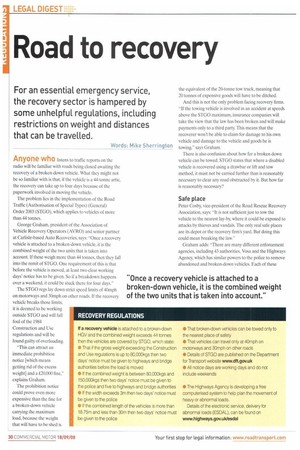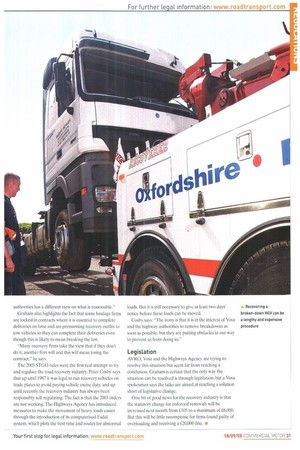Road to recovery
Page 30

Page 31

If you've noticed an error in this article please click here to report it so we can fix it.
For an essential emergency service, the recovery sector is hampered by some unhelpful regulations, including restrictions on weight and distances that can be travelled.
Words: Mike Sherrington Anyone who listens to traffic reports on the radio will be familiar with roads being closed awaiting the recovery of a broken-down vehicle. What they might not be so familiar with is that, if the vehicle is a 4-4-tonne artic, the recovery can take up to four days because of the paperwork involved in moving the vehicle.
The problem lies in the implementation of the Road Traffic (Authorisation of Special Types) (General) Order 2003 (STGO), which applies to vehicles of more than 44 tonnes.
George Graham, president of the Association of Vehicle Recovery Operators (AVRO) and senior partner at Carlisle-based Auto Recoveries, says: "Once a recovery vehicle is attached to a broken-down vehicle, it is the combined weight of the two units that is taken into account. If these weigh more than 44 tonnes, then they fall into the remit of STGO. One requirement of this is that before the vehicle is moved, at least two clear working days' notice has to be given. So if a breakdown happens over a weekend, it could be stuck there for four days.
The STGO regs lay down strict speed limits of 40mph on motorways and 30mph on other roads. If the recovery vehicle breaks those limits, it is deemed lobe working outside STGO and will fall foul of the 1984 Construction and Use regulations and will be found guilty of overloading.
"This can attract an immediate prohibition notice [which means getting rid of the excess weight] and a £20,000 fine,explains Graham.
The prohibition notice could prove even more expensive than the fine for a broken-down vehicle carrying the maximum load, because the weight that will have to be shed is the equivalent of the 20-tonne tow truck, meaning that 20 tonnes of expensive goods will have to be ditched.
And this is not the only problem facing recovery firms. "If the towing vehicle is involved in an accident at speeds above the STGO maximum, insurance companies will take the view that the law has been broken and will make payments only to a third party. This means that the recoverer won't be able to claim for damage to his own vehicle and damage to the vehicle and goods he is towing." says Graham.
There is also confusion about how far a broken down vehicle can be towed. STGO states that where a disabled vehicle is recovered using a drawbar or lift and tow method, it must not be carried further than is reasonably necessary to clear any road obstructed by it. But how far is reasonably necessary?
Safe place
Peter Cosby, vice-president of the Road Rescue Recovery Association, says: "It is not sufficient just to tow the vehicle to the nearest lay-by, where it could be exposed to attacks by thieves and vandals. The only real safe places are its depot or the recovery firm's yard. But doing this could mean breaking the law."
Graham adds: -There are many different enforcement agencies, including 43 authorities, Vosa and the Highways Agency which has similar powers to the police to remove abandoned and broken-down vehicles. Each of these
authorities has a different view on what is reasonable."
Graham also highlights the fact that some haulage firms are locked in contracts where it is essential to complete deliveries on time and are pressurising recovery outfits to tow vehicles so they can complete their deliveries even though this is likely to mean breaking the law.
"Many recovery firms take the view that if they don't do it, another firm will and this will mean losing the contract," he says.
The 2003 STGO rules were the first real attempt to try and regulate the road recovery industry. Peter Cosby says that up until 1987 it was legal to run recovery vehicles on trade plates to avoid paying vehicle excise duty, and up until recently the recovery industry has always been responsibly self-regulating. The fact is that the 2003 orders are not working. The Highways Agency has introduced measures to make the movement of heavy loads easier through the introduction of its computerised Esdal system, which plots the best time and routes for abnormal loads. But it is still necessary to give at least two days' notice before these loads can be moved.
Cosby says: "The irony is that it is in the interest of Vasa and the highway authorities to remove breakdowns as soon as possible, but they are putting obstacles in our way to prevent us from doing so."
Legislation AVRO, Vosa and the Highways Agency are trying to resolve this situation but seem far from reaching a conclusion. Graham is certain that the only way the situation can be resolved is through legislation, but a Vosa spokesman says the talks are aimed at reaching a solution short of legislative change.
One bit of good news for the recovery industry is that the statutory charge for enforced removals will he increased next month from £105 to a maximum of 16,000. But this will be little recompense for firms found guilty of overloading and receiving a £20,000 fine. w












































































































































































